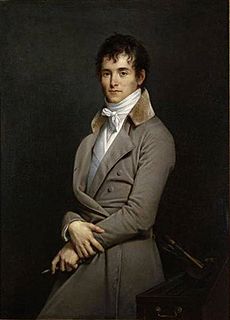Pierre-Narcisse Guérin facts for kids
Quick facts for kids
Pierre-Narcisse, baron Guérin
|
|
|---|---|

Portrait of Guérin by Robert Lefèvre (1801)
|
|
| Born | 13 March 1774 Paris, France
|
| Died | 6 July 1833 (aged 59) |
| Nationality | French |
| Known for | Painting |
|
Notable work
|
Jeune fille en buste |
Pierre-Narcisse, baron Guérin (born March 13, 1774 – died July 6, 1833) was a famous French painter. He was born in Paris, France.
Contents
About Pierre-Narcisse Guérin
Pierre-Narcisse Guérin was a student of Jean-Baptiste Regnault, another well-known painter. In 1796, Guérin won one of the top art prizes, called the grand prix. This was a big deal because the competition hadn't happened for three years.
In 1799, his painting Marcus Sextus was shown in an art exhibition called the Salon. People loved it! The painting showed a man returning home to find his wife dead and his house in mourning. This story reminded people of the difficult times during the French Revolution.
Guérin was publicly honored for his painting. He then went to Rome to study art further.
His Famous Paintings
In 1800, Guérin had to leave Rome because he wasn't feeling well. He went to Naples and painted The Shepherds in the Tomb of Amyntas.
Two years later, in 1802, he created Phaedra and Hippolytus. This painting is now in the Louvre Museum in Paris.
After returning to Paris in 1810, he had another big hit with Andromache and Pyrrhus, also at the Louvre. That same year, he showed Aurora and Cephalus and Bonaparte and the Rebels of Cairo. His paintings were very dramatic and grand, which was popular during the time of the First French Empire.
Later Life and Honors
When the French monarchy was restored, Guérin received more honors. In 1803, he was given the cross of the Legion of Honour, a very important award. In 1815, King Louis XVIII made him a member of the Académie des Beaux-Arts, a famous art academy.
His painting style changed to fit what people liked. For example, in Aeneas Relating to Dido the Disasters of Troy, he used a more colorful and emotional style.
Guérin was asked to paint a scene for the Madeleine church in Paris. However, his health problems stopped him from finishing it. In 1822, he became the director of the French Academy in Rome. He had turned down this job in 1816, but accepted it later.
When he came back to Paris in 1828, Guérin was given the title of "nobleman." He tried to finish a painting called Pyrrhus and Priam, which he started in Rome. But his health got worse. He went back to Italy hoping to feel better, but he passed away in Rome on July 6, 1833. He was buried next to another famous painter, Claude Lorrain, in the church of La Trinité de Monti.
One of Guérin's heroic portraits hangs in the Basilica of the National Shrine of the Assumption of the Blessed Virgin Mary in Baltimore, USA. This painting, given by King Louis XVIII in 1821, shows the Descent from the Cross.
His Students
Many artists learned from Guérin. Some of his famous students include Eugène Delacroix, Théodore Géricault, Ary Scheffer, and Hendrik Scheffer.
Selected Paintings
See also
 In Spanish: Pierre-Narcisse Guérin para niños
In Spanish: Pierre-Narcisse Guérin para niños



